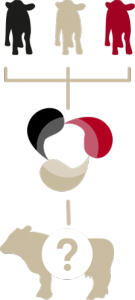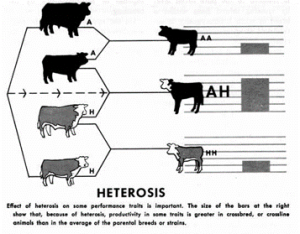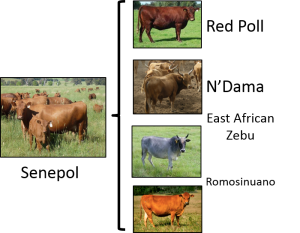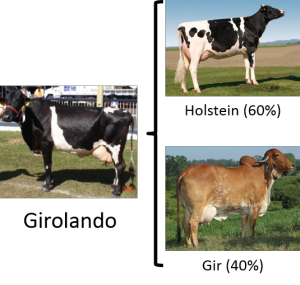By: Connor Owens
What is Crossbreeding?
The mating of two animals from different breeds. Normally, the breeds have complimentary traits that will enhance the economic value of the offspring. (4)
Why use Crossbreeding?
With most breeding strategies today, there tends to be an increase in inbreeding and therefore inbreeding depression within a herd. With this increase in inbreeding, the animals of the herd are less likely to be reproductively successful. One of the main benefits of using crossbreeding is that there is less inbreeding within the herd and an increase in heterosis, which is the increase of the performance of an individual when compared to the average performance of their parents. Heterosis is also sometimes called hybrid vigor.
One large problem that has risen in herds is low fertility and calving ease, especially in Holsteins. By incorporating crossbreeding, a breeder can improve both of these traits with out a risk of increasing inbreeding. (1)
The Different Crossbreeding Systems
The crossbreeding system a producer uses varies depending on the goals they have for the farm, both short term and long term. Some farms will only crossbreed for a certain amount of time. They will implement crossbreeding until they get to a point where they have the uniformity within the herd that they would like. Others will continually use crossbreeding to make sure there is a constant level of heterosis within the herd. The level of crossbreeding that the breeder uses also depends on what they are trying to select for within the herd. Pro-Cross is a popular system that selects for multiple traits.

Pro-Cross (3)
This system implements the use of Swedish Reds for their calving ease, udder health, and high production, Montebeliarde for their feet/leg conformation, high quality protein, and adapting body condition, and Holsteins for their milk production and udder conformation. There is a rotation in the breed of the bull used each generation so that there can be high heterosis and the traits received are not diluted. It can be easily implemented into most United States herds due to the high percentage of Holstein herd. Results are seen after the 1st generation, but the most benefit can be seen after about 10 years.
What are Some Common Concerns with Crossbreeding? (1)
There is too much variability in using crossbreeding.
At the start of the implementation of crossbreeding, the uniformity within a herd will be thrown off, which is to be expected. This lack of uniformity can be costly to the producer, especially if they do not commit to the crossbreeding program in the long term.
It takes too long to see any results.
In order for a producer to get the most out of crossbreeding, they must be willing to commit to using the program for several generations. Some farmers do not have the time and/or money to do this, so this a large factor to consider if interested in starting crossbreeding.
Examples of Breeds that Resulted from Crossbreeding
Many breeds that we know today arose from crossbreeding and were once considered “composite breeds,” another term for a breed that has arisen from crossbreeding. After generations of selection, the crossbreed starts to become more uniform phenotypically and genetically.
Senepol (6):
Composite breed developed in St. Croix in the US Virgin Islands that arose from selecting for heat tolerance, being polled, gentle temperament, and good production. Recent research has found traces of Zebu DNA, when it was initially thought Senepol only arose from Red Poll and N’Dama.
Girolando (2):
Arose in the 1940s in Brazil when farmers crossed Gir with Holstein cattle. They are now responsible for 80% of Brazil’s milk production. Characteristics such as udder capacity, reproductive efficiency, and forage conversion are perfect for high production in tropical climates.
Recent Research Being Conducted
One issue that arises in studying crossbreeding is designing experiments to analyze its effects. Most results are based on field data with out an initial experimental design. A planned experiment in crossbreeding would be extremely costly, as many cows would need to be used over several generations. The following studies have come from observing multiple sets of data from the field.
Crossbreeding in dairy cattle: International trends and results from crossbreeding data in Germany – H.H. Swalve, 2007 (7)
A study was conducted in Germany comparing purebred producers to crossbred producers. They found that crossbreeding has shown a significant improvement in functional traits such as fertility and survivability, but this compared first generation animals. Further research needs to be conducted on the effects of crossbreeding in subsequent generations. This also is specifically looking at European and North American conditions, so more research would need to be done in order to collect data from other parts of the world.
The influence of additive and nonadditive gene action on lifetime yields and profitability of dairy cattle – A.J MacAllister, 1994 (5)
This study used about 5070 cattle from Holstein purebred, Ayrshire purebred, and crossbreed groups of these two breeds. When analyzing traits such as milk yield, fat, protein, and lactose, lifetime yields and milk value were similar between Holsteins and the crossbreeds, while reproductive rate was better in the crossbreed lines. If selecting for lifetime yields and profitability, there appears to be more improvement using a rotational crossbreeding system with two breeds.



